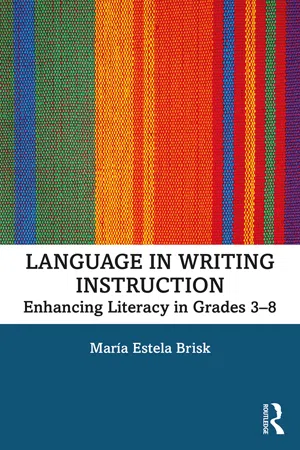
- 190 pages
- English
- ePUB (mobile friendly)
- Available on iOS & Android
About This Book
Accessible and engaging, this book offers a comfortable entry point to integrating language instruction in writing units in grades 3–8. A full understanding of language development is necessary for teaching writing in a successful and meaningful way. Applying a Systemic Functional Linguistics (SFL) approach, María Brisk embraces an educator's perspective, breaks down the challenges of teaching language for non-linguists, and demonstrates how teachers can help students express their ideas and create cohesive texts.
With a focus on the needs of all students, including bilingual and English language learners, Brisk addresses topics necessary for successful language instruction, and moves beyond vocabulary and grammar to address meaning-making and genre. This book provides a wealth of tools and examples for practice and includes helpful instructional resources that teachers can return to time after time. Moving from theory to practice, this teacher-friendly text is a vital resource for courses in language education programs, in-service teacher-training seminars, and for pre-service and practicing English Language Arts (ELA) teachers who want to expand their teaching abilities and knowledge bases. This book features a sample unit and a reference list of instructional resources.
Frequently asked questions
Information
1

Putting Language into Writing Instruction Matters:

Putting Language into Writing Instruction Matters: A Framework for Teaching

Systemic Functional Linguistics (SFL)
Language Instruction
Table of contents
- Cover
- Half Title
- Title Page
- Copyright Page
- Table of Contents
- Preface
- 1. Putting Language into Writing Instruction Matters: A Framework for Teaching
- 2. Language to Develop the Topic
- 3. Language to Express Complex Ideas
- 4. Language to Connect with Audience
- 5. Language that Makes a Text Come Together
- 6. Language Instruction in the Context of Genre Pedagogy and Disciplinary Content
- Instructional Resources
- Index